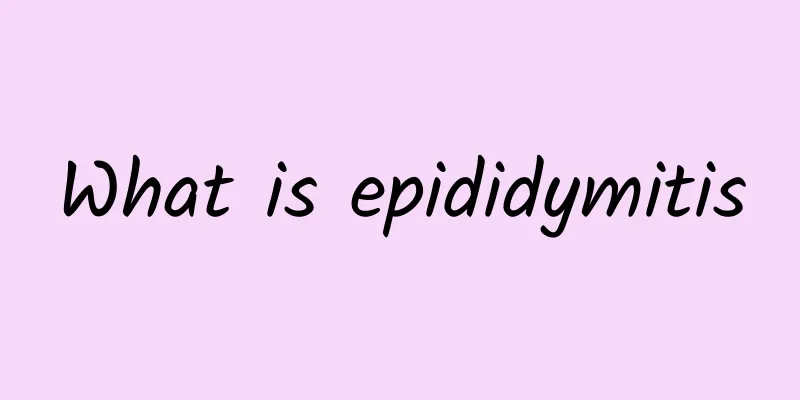What causes testicular drooping and pain?

|
Some men may have problems such as drooping and painful testicles. This is due to orchitis caused by bacterial or viral infection. Symptoms include fever, enlarged testicles, and pain. They are usually classified as chronic or acute. Sometimes the symptoms are severe and sometimes mild. When you touch the testicles with your hands, you may find small nodules inside accompanied by pain. So what should you do? reason Causes of scrotal pain Orchitis is an inflammatory disease of the testicles caused by various pathogenic factors. It can be divided into non-specific, viral, fungal, spirochetal, parasitic, damaging, chemical and other types. Specific orchitis is mostly caused by epididymal tuberculosis invading the testicles, which is very rare. Clinically, non-specific orchitis and mumps orchitis are common, and it is one of the common causes of male infertility. (I) Acute non-specific orchitis: Acute non-specific orchitis often occurs in patients with urethritis, cystitis, prostatitis, prostatectomy and long-term indwelling catheters. The infection spreads to the epididymis through the lymph or vas deferens, causing epididymal orchitis. Common pathogens are Escherichia coli, Proteus, Staphylococcus aureus and Pseudomonas aeruginosa. Bacteria can spread to the testicles through the bloodstream, causing simple orchitis. However, the testicles have rich blood supply and strong resistance to infection, so this situation is relatively rare. Pathologically, the main macroscopic observation is enlarged, congested and tense testicles. Small abscesses are seen when the testicles are cut open. Histological examination showed focal necrosis, edema of connective tissue and infiltration of lobed granulocytes, inflammation, hemorrhage and necrosis of seminiferous tubules, and in severe cases, testicular abscess and testicular infarction. (II) Chronic non-specific orchitis: Chronic orchitis is mostly caused by incomplete treatment of non-specific acute orchitis. It can also be caused by fungal, spirochetal, or parasitic infections, such as testicular syphilis. Patients with previous testicular trauma may develop granulomatous orchitis. Local or systemic radioactive isotope phosphorus irradiation of the testicles may also cause orchitis, destroying the testicular tissue. Pathologically, the testicles are enlarged or hardened and atrophied, the basement membrane of the seminiferous tubules is hyalinized and degenerative, and the spermatogenic epithelial cells disappear. There may be hardening around the seminiferous tubules, and small hyperplastic foci may also form. (III) Acute mumps orchitis: Mumps is the most common cause of orchitis, and about 20% of mumps patients have orchitis. It is more common in late adolescence. The testicles are highly enlarged and purple-blue in color. When the testicles are cut open, the testicular tubules cannot be squeezed out due to the reaction and edema of the interstitial tissue. Histological observations show edema and vascular dilation, a large number of inflammatory cells infiltrate, and varying degrees of degeneration of the seminiferous tubules. When orchitis heals, the testicles become smaller and soft. The seminiferous tubules are severely atrophied, but the testicular interstitial cells are preserved, so the secretion of testosterone is not affected. Check Examination and diagnosis of scrotal prolapse and pain In the acute phase, there is high fever, chills, and testicular pain radiating to the groin, accompanied by nausea and vomiting. Acute mumps orchitis usually occurs 3-4 days after the onset of mumps, with a high fever of up to 40°C, often accompanied by prostration, red and swollen scrotum, enlarged testicles, hydrocele, and obvious tenderness. If it is mumps, enlarged parotid glands may also be found. Relief methods Prevention of scrotal prolapse and pain For orchitis, a large amount of broad-spectrum effective antibiotics should be applied intravenously in the early stage to control inflammation in order to reduce the occurrence of purulent orchitis and testicular abscess. Special attention should be paid to acute mumps orchitis, whose bilateral lesions can cause irreversible damage to spermatogenesis and even testicular atrophy, leading to male infertility. Therefore, the key to preventing this disease is that susceptible children under 1 year old can be vaccinated. The application of live attenuated mumps virus vaccine can prevent mumps and concurrent orchitis, and mumps hyperimmune globulin can reduce the development of the disease. The routine use of estrogen or adrenal glucocorticoids may have the effect of preventing orchitis in children with mumps, but there is still controversy. |
<<: Is it normal to have blood on the testicles?
>>: What are the sexual needs of a 35-year-old man?
Recommend
What to pay attention to after circumcision
Circumcision is a very common disease in life. Th...
What's going on with all the red spots on the glans?
I wonder if male friends have ever experienced th...
How to quickly remove arm bruises, there are tricks to remove bruises
In daily life, we may get bruises on some parts o...
The organ that produces sperm in men is
Male sperm is not produced immediately, but there...
How to treat a dark complexion in men? These methods are very effective
In comparison, women pay more attention to facial...
Anterior gland hypertrophy
Prostate disease occurs in men, but most of them ...
Red and swollen glans eye
Speaking of the glans penis, it is necessary for ...
The glans penis secretes white tofu residue
Men need to pay attention to reproductive health....
What should I do if my husband is not hard enough?
One of the things men fear the most is that their...
Why do men's palms and feet feel hot?
For men, if the palms and feet are hot, you shoul...
I've learned a lot! It's actually the cause of my inability to urinate and my inability to urinate completely.
Do you feel like you can't urinate with force...
What are the disadvantages of pearl rash
Most of the patients with pearly rash are adolesc...
How to take care of a man's thick and oily skin
In fact, when men and women are in love, they oft...
Things to note after circumcision surgery, scientific care to speed up healing
Many men have phimosis. Excessive foreskin affect...
How to make cold wild amaranth, wild amaranth tastes better when cooked this way
Wild amaranth is a common type of wild vegetable ...









